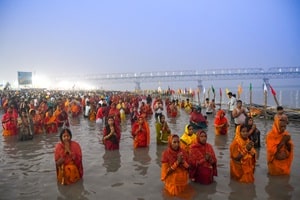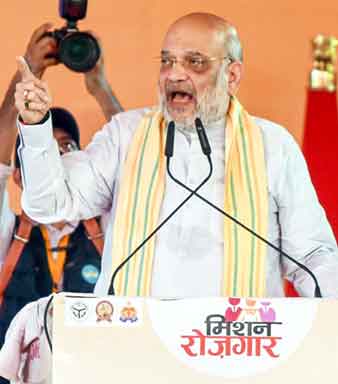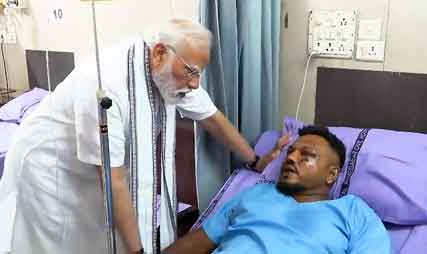Chhath Puja, a unique and deeply spiritual festival celebrated with immense devotion, primarily in Bihar, Jharkhand, and parts of Uttar Pradesh, as well as in Nepal's Mithila region, began on Tuesday.
The festival, which honours Surya (the Sun God) and Chhathi Maiya (His sister), is observed over four days and includes a series of elaborate rituals that symbolise purification, gratitude, and dedication.
The first day, known as Nahai Khai, marks the beginning of the Chhath rituals. Devotees, called Chhathvratis, start the day by bathing in rivers or ponds to purify themselves.
They then wear new clothes and prepare a simple meal that usually includes bottle gourd (kaddu), gram pulse (chana dal), and rice. This combination of 'satvik' (pure, unadulterated) food, devoid of any spices other than rock salt, is believed to cleanse the mind and bring positivity into the lives of the devotees. Eating this prasad is an essential ritual, signifying purity, discipline, and a fresh start.
Following this, the Chhathvratis take a vow to fast strictly for the next three days, during which they must observe rigorous discipline, including abstaining from certain foods, adhering to prescribed standards of cleanliness, and dedicating themselves fully to the worship of the Sun God.
The entire family also participates in these customs, reinforcing familial bonds and unity. Chhath songs, sung in reverence to Chhathi Maiya, add a soulful touch to the festival, carrying forward the folk traditions and devotions that have been passed down through generations.
The colours yellow and red have special significance during the festival, symbolising purity and devotion. Although other colours can be worn, yellow and red are preferred for their cultural and spiritual symbolism.
The Chhath festival is marked by its intense and disciplined rituals, which reflect the profound dedication of Chhathvratis to the Sun God and Chhathi Maiya.
This festival is known for its strict fasting rules, as Chhathvratis abstain from water and food for about 36 hours, a challenging practice that devotees approach with faith and conviction. Remarkably, many who observe this rigorous fast say that it is manageable and not burdensome, emphasising the power of devotion in their endurance.
On the first day of Chhath (Nahay Khay) cooking is done on a traditional wood-burning stove, fueled specifically by mango wood, a modern kitchen stove is generally avoided.
This setup underscores the importance of following ancient practices. Every step is carefully observed, from using only the purest ingredients and rock salt to avoiding any utensils or ingredients associated with non-satvik ('tamasic', as they are associated with the impure, hence not preferred) qualities, such as onions, garlic, and animal-based foods.
The home is purified in preparation, tamasic items are removed entirely, reflecting the importance of creating a spiritually clean and calm environment.
Once the food is prepared, it is first offered to the Sun God as a sacred offering, symbolising gratitude and reverence. Only after the Chhathvratis consume the Prasad can other family members eat.
Clean, fresh clothes are worn and devotees sleep on the floor, often with only a simple mat or sheet for comfort, as a mark of humility and simplicity.
Chhath is a festival rooted in faith, emphasising self-discipline, purity, and a connection with nature.
The wish-fulfilling aspect of the festival is a significant part of its appeal, as devotees believe that observing the Chhath fast with full devotion will grant their prayers, especially those related to marital harmony, progeny, and general happiness.
The central act of Surya (Sun God) worship embodies the gratitude for life and nature's sustenance, which lies at the heart of this ancient celebration.
The Chhath festival honours Chhathi Maiya, who is revered as the sister of the Sun God. According to tradition, Chhathi Maiya bestows blessings on those who observe the rituals with strict adherence to purity and discipline.
The fast is seen as an act of devotion that pleases the gods, bringing health, happiness, and fulfilment of wishes, especially for children and familial bliss. the main offering to Chhathi Maiya during the festival is Thekua, a special prasad made from wheat flour, sugar or jaggery, and ghee, symbolising nourishment and simplicity.
This sacred sweet, along with other carefully selected offerings which are some of the fresh crops of the season, represents the bounty of nature and devotion.
The Chhath Puja requires various items, each symbolising a facet of reverence and devotion to the Sun God and Chhathi Maiya. Essential items include large bamboo baskets used for carrying the offerings and symbolic of traditional culture, brass or bamboo 'soop' (an open object often used to separate husk from grain, and do other similar tasks), lota (small vessels for water), and earthen diyas (lamps), along with seasonal fruits and vegetables, sugarcane, betel leaves, betel nuts, and milk.
The origin of Chhath is rooted in mythology
According to an ancient story, there was once a king named Priyavrat and his queen Malini. They were childless and deeply distressed by this.
Sage (Maharishi) Kashyap advised the king to perform a special Yagya (sacrificial ritual) to bless them with a child. Following this, the queen indeed gave birth, but the child was born lifeless, plunging the royal couple into greater sorrow.
At that time, the goddess Shashthi (another name for Chhathi Maiya), the Manas Putri or "mind-born daughter" of Brahma, descended from the heavens. She introduced herself to the grieving king, revealing that she blesses childless parents with progeny.
In compassion, she touched the lifeless child, bringing him back to life. Overjoyed, King Priyavrat and Queen Malini worshipped Shashthi Devi out of gratitude.
This act of reverence and her blessing led to the widespread tradition of Chhath Puja, celebrated to this day in honour of Shashthi Maiya, the goddess of fertility and protector of children.
This legend reinforces Chhath’s central themes of faith, purity, and gratitude to the divine powers that sustain life.
The Chhath Puja festival in 2024 begins on 5 November with Nahay Khay. The second day, Kharna falls on November 6. This day is crucial, as devotees prepare kheer (a pudding made from rice and jaggery, sometimes with sugarcane juice) along with roti.
This kheer serves as a final, filling meal before the 36-hour fast begins, and it is an important offering to Chhathi Maiya and the Sun God. After eating the prasad of kheer and roti, Chhathvratis begin their strict fast, abstaining from food and water until the festival’s conclusion.
The third day, November 7, is the evening when the first Arghya (offering) is presented to the setting Sun God. Devotees gather at riverbanks, lakes, or ponds to offer prayers to the Sun as it sets, accompanied by traditional songs and rituals. This evening Arghya represents gratitude for the day’s light and sustenance provided by the Sun.
The final day, November 8, marks the morning Arghya, offered to the rising Sun. As dawn breaks, devotees once again gather near water bodies to offer their final prayers and gratitude to the Sun. This concluding ritual is deeply symbolic, as it signifies new beginnings, hope, and the fulfilment of wishes. After the Arghya to the rising Sun, devotees break their fast, marking the end of Chhath Puja.
Each day of Chhath Puja emphasises discipline, purity, and gratitude, reinforcing the festival’s themes of devotion to nature and the divine. The four-day celebration connects families, communities, and generations through shared customs and deep reverence for the Sun God and his sister Chhathi Maiya.






Civil Aviation Ministry issues strict instructions to DGCA to enforce chopper safety
In the wake of a tragic helicopter crash in the Gaurikund area of Uttarakhand, the Ministry of Civil Aviation on Sunday issued strict instructions to the Directorate General of Civil Aviation (DGCA) to enforce all safety protocols related to chopper operations in hilly and sensitive areas like the Kedarnath valley.
‘Harming Indians will invite punishment’, HM Shah on Op Sindoor
Union Home Minister Amit Shah said on Sunday that through the anti-terror Operation Sindoor, Prime Minister Narendra Modi has sent a strong message across the world that the bloodshed of Indians will invite punishment.
Dassault CEO trashes Pakistan's claims on downing Rafale jets
Dassault Aviation Chairman and CEO Eric Trappier has dismissed as "factually incorrect" Pakistan’s claims about having shot down three Rafale fighter jets of the Indian Air Force during Operation Sindoor.
Tripura BJP stages protest over vandalism at Tagore's ancestral home in B'desh
Ruling BJP in Tripura on Saturday staged state-wide protests along the Bangladesh border, protesting the recent attack and vandalism of the ancestral home of Nobel laureate Rabindranath Tagore in the neighbouring country.
Two new earthworm species unearthed in Tripura
In a major breakthrough for ecological science in Northeast India, two new species of earthworms—Kanchuria tripuraensis and Kanchuria priyasankari—have been formally identified in Tripura.
CM calls for mass awareness on voluntary blood donation
Chief Minister Prof. Dr. Manik Saha today urged to create massive awareness campaigns about the benefits of voluntary blood donation to encourage more people to donate blood.
Tripura has begun experimental soilless hydroponic farming: Minister
The Tripura government has experimentally started the hydroponics method of cultivation without any soil, the state’s agriculture minister Ratan Lal Nath said here on Friday.
Assam Rifles seized cannabis worth Rs 30 lakh from Tripura
In a swift and decisive operation against narcotics smuggling, Assam Rifles, in close coordination with representatives of the Directorate of Revenue Intelligence (DRI), successfully seized approximately 195 kg of marijuana from the general area of Taranagar, Agartala during the early hours of 12 June.